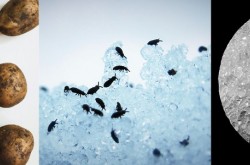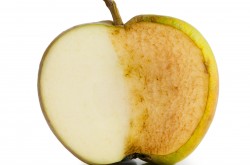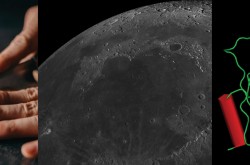3 things you should know about why wool keeps us warm, and about its surprising uses in the garden and in space.

Meet Cassandra Marion, Renée-Claude Goulet, and Michelle Campbell Mekarski.
They are Ingenium’s science advisors, providing expert scientific advice on key subjects relating to the Canada Aviation and Space Museum, the Canada Agriculture and Food Museum, and the Canada Science and Technology Museum.
In this colourful monthly blog series, Ingenium’s science advisors offer up quirky nuggets related to their areas of expertise. For the March edition, they explain why wool keeps us warm, how it can be used to improve soil, and how it can help prevent fires in spacecraft!

Insulating, durable, fire-resistant, odour-resistant, UV-resistant, moisture-wicking… is there anything wool can’t do??
Why does wool keep us warm?
When it comes to packing for an outdoor adventure, one of the first things that avid hikers, campers, and outdoors enthusiasts will tell you is: don’t wear cotton, wear wool.
Wool is durable, it is fire resistant, it wicks away moisture, it keeps you cool in warm weather, and it keeps you warm in cold weather. Even when wet, wool still does a decent job of keeping you warm. And if that wasn’t enough, wool doesn’t get as stinky from body odor as other materials because it’s resistant to microbes!
So what is it about wool that gives it all these impressive properties? When it comes to warmth, it’s all in the shape and construction of the fibres. If you were to look really closely at a single strand of wool, you would see that the strand is covered in lots of tiny overlapping scales. These scales shed water very much like the shingles on a roof, allowing moisture like sweat to escape the fabric. The small amount of moisture that wool does absorb gets trapped inside the fibre underneath those scales. This means that even if there’s some water absorbed, it’s kept locked away from your skin, leaving you dry and warm.
Another property of wool that makes it ideal for outdoor adventures is the texture of the fibres. If you were to look at some wool and cotton cloth under a microscope, you would see that both are made of interwoven fibres. Cotton fibres tend to be fairly straight, whereas wool fibres are full of bends and curls. All those bends and curls mean that woolen cloth contains many more tiny air pockets than cotton cloth. Air is a bad conductor of heat, which means that is does not pull heat away from your body and let it escape to your surroundings. The more pockets of air you surround yourself with, the more of your body heat will be trapped against your body, and the warmer you will be. This same property is why wool can keep you cool in hot temperatures. It’s like surrounding yourself with a cozy Styrofoam cooler. The pockets of air in Styrofoam act as an insulator for heat or cold. The same concept applies for wool.
This combination of properties in wool makes it one of the best natural insulators on Earth. Sheep certainly take advantage of their protective coats to stay warm and dry. So the next time you’re packing for an outdoor adventure, follow their example and consider wool.
By Michelle Campbell Mekarski

Compressing raw wool into pellets turns a waste product into a useful resource.
Springtime means putting away our woolly clothes and taking out our woolly…fertilizer?
Wool, a natural, biodegradable fibre, has traits making it an excellent material for clothes and insulation...and boosting soil health! Born out of the local agriculture movement, and a shift in how we think about waste, pelleted wool is a hot, new fertilizer and soil conditioner now available to gardeners in Canada! Pelleted wool is an example of upcycling, or recycling a disposable product into something of greater value or use.
The wool on sheep is not all equal. In fact, after a sheep is shorn, the low-quality belly, leg, and neck wool usually goes to the compost heap, while the rest of the wool goes on to be processed. Unless you are raising sheep specifically for their fibre, it costs more to shear a sheep than you get from selling the wool, which poses an economical challenge for small-scale farmers who raise sheep for meat. People have used waste wool as mulch and compost in the garden for a very long time, but now, enterprising wool growers and processors have found a way to modernize the practise, and create an extra source of income for smallholder farms.
The machinery for pelleting wool already existed for making animal feed and wood pellets, and was simply adapted for this new use. Handfuls of dirty, unwashed wool are put into the machine, then rollers push the wool through small holes in a metal plate, and pellets come out the other side. It works a bit like a pasta maker or a meat grinder. Currently, feeding the pelleting machine is a manual job so it's done at small scale. The production is also seasonal, as the bulk of the waste wool is available in the spring, when sheep are shorn.
So what makes these pellets good for the garden? Wool, just like any other animal hair - including our own - is made of keratin, a protein. Proteins are rich in carbon and nitrogen, and like other biological materials, can be broken down and recycled in nature. Wool trimmings also contain all kinds of other debris, such as manure, hay, and dirt, which have their own "nutritional value." Soil organisms decompose pellets incorporated in the soil, and the nitrogen they contain becomes available to plants, while the carbon stays stored away in the soil. Another benefit of wool pellets: they improve soil’s ability to hold water, thus reducing watering needs.
At the moment, there are few scientific studies on wool pellets, but research projects like the Vermont Wool Pellet Project are showing promising results. While there is a lot more to learn about how exactly they work with the soil, in field trials, researchers showed wool pellets could be a viable alternative to other forms of nitrogen fertilizers.
By treating waste wool from local farms as a valuable resource, entrepreneurs are creating a value-added product, providing a new tool for sustainable agriculture, and a new source of income for sheep farmers. This type of innovation is important in developing our local processing industries and creating healthy and resilient agricultural systems. So, this spring, why not try out this new product in your own garden, and help grow the sustainability movement in Canada!
By Renée-Claude Goulet

Shaun the Sheep in front of a model of ESA’s European Service Module.
Wool to protect Artemis astronauts in case of fire
Shaun the Sheep isn’t the only wool hitching a ride on the Orion spacecraft headed for the Moon. A new wool prefilter has been added to the contingency breathing apparatus – a respirator on board the Artemis program’s human rated capsule, Orion.
On Earth and in space, prevention is the number one rule in fire safety. In the event of a fire on the International Space Station, astronauts may require a respirator for a short time, but are able to quickly move to another module unaffected by the fire and close the hatch behind them. If necessary, they can even return to Earth, land and exit the spacecraft. On Orion, however, that’s not an option. It’s a small vehicle that will travel beyond Earth’s orbit with no place for astronauts to escape to unless Orion is docked to another spacecraft. And there is certainly no opportunity to quickly land and evacuate. An assessment of Orion’s Fire Safety Plan identified these issues and the need to extend the life and capabilities of the emergency respirators in case the astronauts needed to use them for a long period of time. The respirator is outfitted with a cartridge containing a series of filters meant to trap gases and particulates, as well as oxidize carbon monoxide. The whole of the cartridge now has a wool prefilter, that is, a piece of wool that clips on the outside of the cartridge and that can easily be changed once it is loaded with particulates and water mist.
A New Zealand company has been contracted by NASA to supply the wool filters made from specially bred sheep which produce Merino wool with enhanced filtering properties. The wool is flame retardant up to 600 degrees Celsius, and has extremely low breathing resistance, making it comfortable to breathe through while effectively capturing unwanted hot particles from the air. In addition to use in space, this wool filter technology is also used by firefighters, for home air purifiers, face masks, and personal protective equipment.
Wool also makes for great astronaut clothing. Merino wool in particular is thinner and softer than regular wool. It has many practical properties: elasticity, moisture management for comfort; odour- and static-resistance, antimicrobial characteristics, and breathability. On board the space station, astronauts get multiple uses from their clothes, but do not have time or water to spend laundering them. Once dirty, clothes are discarded. For long duration space flight, where weight is at a premium, discarding clothes isn’t realistic, so using a robust fabric like merino wool may be in cards.
Finally, the woolly stuffed animal Shaun the Sheep was chosen by the European Space Agency (ESA) to fly to the Moon in the uncrewed Orion spacecraft during the Artemis I mission. They noted it was a ‘giant leap for lambkind’.
Time ‘wool’ tell what future uses this amazing natural fabric may have in space exploration.
By Cassandra Marion
Enjoying the Ingenium Channel? Help us improve your experience with a short survey!








































